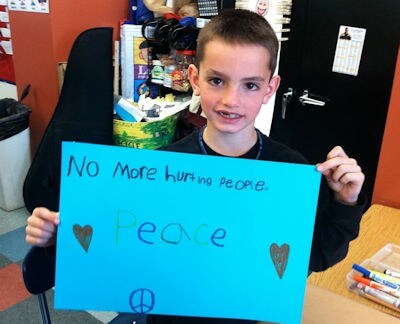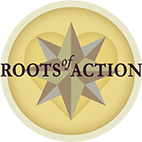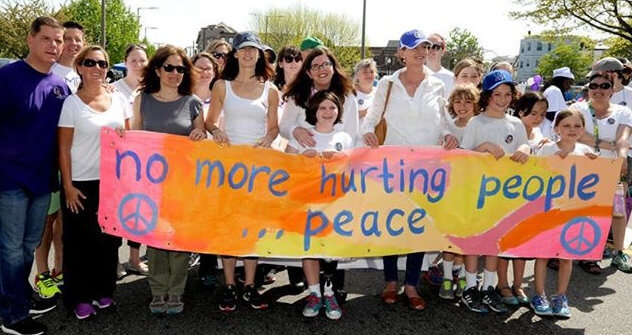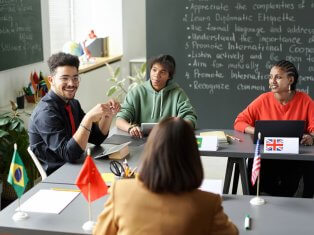
Martin Richard lost his life when the second of two bombs exploded near the finish line of the Boston Marathon in 2013. This 8-year-old boy believed in peace and kindness, values he proudly displayed on a poster he made at school.
How do we honor Martin’s wish for a more peaceful world—a world that spreads Martin’s own words No More Hurting People?
How do we increase the happiness and well-being of every child?
We start by teaching children to care about others every day throughout the year.
Learning to be givers shapes children’s values and provides opportunities to develop kindness, a virtue that improves lives and reduces violence and bullying.
Empathy is our ability to recognize and respond to the needs and suffering of others. We can see empathy-in-action all around us. In Tomorrow’s Change Makers: Reclaiming the Power of Citizenship for a New Generation, young people describe the transformative power of empathy and how it motivated them to make a difference for others. An important part of our internal compass, empathy includes the ways we show caring and compassion to people in our lives.
Most parents, grandparents, and teachers show kindness to children every day. We give them love and attention. We buy gifts, bake special treats, and work extra hard to make children feel a part of their families, cultures, and faith communities.
Do our acts of kindness on behalf of children make us happier adults? Of course they do.
In fact, studies show that we feel better about ourselves when we practice kindness—toward our children, students, families, friends, and communities. Not only do good deeds make us feel better, but as David Brooks explained in the New York Times article Nice Guys Finish First, people who are kind and compassionate are often the most successful.
The Kindness Dilemma
While kindness might seem pretty straightforward to learn, it’s a bit more complex than meets the eye.
We don’t make children happy when we simply enable them to be receivers of kindness. We escalate their feelings of happiness, improve their well-being, reduce bullying, enrich their friendships, and build peace by teaching them to be givers of kindness.
The handmade poster Martin proudly displayed in the photo is a gift he made for others to see. It was a deeply-felt act. Little did Martin know that his poster would be circulated worldwide following his tragic death. Today, others have joined his personal campaign for peace by sharing posters on social media using the hashtag #NoMoreHurtingPeople. What a testament to the idea that kindness can grow through the efforts of one child!
Children are born to be givers. But by 4th grade, research shows they are socialized to think more about themselves than others. How do we reverse this trend and create long-lasting habits of kindness?
A research study, from the University of British Columbia and the University of California, Riverside, showed the benefits derived by tweens when they were taught strategies to increase their happiness through acts of kindness.
For thirty days, several hundred 9 to 11-year-old children performed and recorded three acts of kindness each week for anyone they chose. Another several hundred kept weekly track of three pleasant places they visited.
Not surprisingly, results compared favorably with adult studies. When kids performed acts of kindness or took notice of the pleasant places they visited, their happiness quotient increased.
But those who performed acts of kindness received an extra boost. The study showed they gained an average of 1.5 friends during the month-long period—good support for the idea that “nice guys finish first.”
Like other studies, this research showed that being kind to other people benefits the giver. For children, it nurtures their well-being and increases their positive connections with peers.
When children learn to be caring and kind, they also benefit developmentally. Well-liked children display more positive, less bullying behaviors when they become teenagers. Happier kids are more likely to show higher academic achievement. Being kind makes you feel good about yourself and improves your outlook on life.
Indeed, 8-year-old Martin Richard became a peace and kindness “bridge-builder” at a very young age, a legacy that will live far beyond his tragic death.
Teaching Kids about Kindness
Applying the Kindness Counts study in your home, classroom, or after-school program is easy. The goal is to help kids become more aware of doing acts of kindness and of their feelings of gratitude when they experience pleasant activities.
Follow these four steps to help enable children to be givers of kindness. Your efforts will be greatly rewarded!
1. Understand the Importance of Kindness
Learn about the benefits of giving for children and adults. Check the web for resources for home and classroom, like The Random Acts of Kindness Foundation.
2. Create a Kindness Project
Devise an activity where your family or classroom records ONE act of kindness or ONE pleasant activity per day. You might call it your “Kindness Project” or “Happiness Diary.” These activities could include helping with dishes, letting someone else go first, taking care of an animal, going out of way the for a friend, hugging someone to make them feel better, etc. Or they might include visits to places and experiences that make us feel good, like visiting a favorite park or a grandparent’s house.
3. Take Time to Share
On a regular weekly basis, take time to share as a family or classroom. Rather than sharing everything in your diary, share the highlights of your week. Share enough so that everyone learns from each other’s acts of kindness and begins to understand the types of experiences that bring gratitude to life. Sharing encourages self-reflection and helps bring meaning to our actions.
4. Practice, Practice, Practice
It may not be practical to keep up a routine where you are sharing from a diary on a regular basis. Reinforcement of the kindness habit comes with practice. But once children get into the habit, it’s easy to share from time to time.
Whether it’s planting a peace garden, making a get-well card for a sick friend, or simply inviting someone new to sit at your school lunch table, there are many free and easy ways kids can help create a more peaceful world.
Visit the Martin Richard Foundation or generationOn, two organizations calling upon youth ages 5-18 to promote peace and create positive change in their schools and communities by engaging in simple acts of kindness or service projects.
(The original version of this article was published Nov. 12, 2013 and updated with new content on Sept. 14, 2015)
Published: September 14, 2015
Tags: acts of kindness, caring, character strengths, classroom practices, empathy, gratitude, happiness, internal rewards, kindness, moral development, parenting, positive values, positive youth development, teachers



